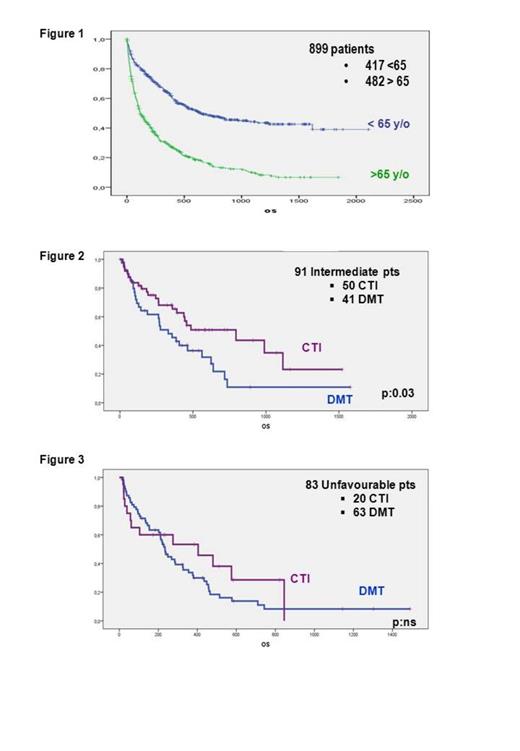Abstract
Introduction
AML is a heterogeneous group of neoplasm according to leukemogenic mechanisms and has variable response to treatment. In addition to age and WBC count at diagnosis, cytogenetic and molecular abnormalities are key factors to assess prognosis. In this work, we evaluated the number of adult AML cases diagnosed between 2009 and 2012 in the French Nord Pas de Calais and Picardie regions (North of France). The aim of the study was the collection of epidemiology data, treatments proposed and their results in real life.
Matérials and Methods
The Nord Pas de Calais and Picardie observatory contains data of all adult patients (>18 years) with AML (>20% marrow blasts) diagnosed in the oncology and/or hematology departments of the following participating Hospitals: Amiens (A), Arras (Ar), Boulogne (B), Dunkerque (D), Lens (L), Lille (CHRU et CH St Vincent (Vi)), Roubaix (R) et Valenciennes (V), whose overall catchment population is close to 6 million inhabitants , allowing a population based registry. A disadvantage of registry data is that investigators cannot control data collection and quality. In our observatory, data were obtained from the declaration of all the participants centralized with a web access reporting data base. The declaration of patients in the database was made both by clinicians, cytogeneticists and molecular biologists. The following data were entered:, disease course, WBC counts, bone marrow blast %, cytogenetics, immunophenotype, molecular biology, treatment received, outcome. To optimize data quality, each kind of data was entered respectively by clinicians, cytogeneticists and molecular biologists. Data were cross validated and the follow up data were updated every years during follow-up of the patients. Data was collected as of October 2013
Results
Between January 2009 and December 2012, 899 patients were enrolled in the observatory, respectively 185 (A), 33 (Ar), 43 (B), 66 (D), 85 (L), 197 (CHRU), 57 (Vi), 98 (R) and 135 (V). Median age was 67 years (range 17 to 97), 54% of patients were older than 65 years, M/F was 1.12 (425 female (47%) et 474 male (53%)). Cytogenetic studies were performed in 87% of the patients, immunophenotype in 57%, molecular biology screening for FLT3 and NPM1 mutation in 61%.
Intent of treatment was conventional chemotherapy (CTi) 50%, demethylating agent (DMT) 18% and best supportive care (BSC) 32% + Low dose cytarabine (LDAC). The overall median survival was 269 days (624d < 65 y and 115d for > 65 y) (fig1). 15% of the patients (132pts) were included in a clinical trial (90 % <65 y and 10% >65 y). Median overall survival of the patients included in a clinical trial and aged <65y was 1121d vs 563d for patients not included in a clinical trial and aged <65y (p:ns).
Of the 482 patients aged >65 y, MRC cytogenetic classification was unfavourable (139 pts; 29%), intermediate (209 pts; 43%), favourable (18 pts; 4%) and not done 116 pts (24%). Overall, in pts aged > 65, treatment was CTI 93 pts (19%), DMT 130 pts (27%), BSC 210 pts (44%), LDAC) 38 pts (8%), others 11 pts (2%). Among pts with unfavourable karyotype treatment was: Cti (14%), DMT (45%), LDAC (2%), BSC (38%) and others (1%). overall median survival in this unfavourable group was 222d with DMT vs 104d with LDAC vs 227d with CTI. In intermediate cytogenetics cases, treatment was Cti (24%), DMT (19%), LDAC (14%), BSC (42%) and other (1%), and median OS was 270d with DMT vs 189d with ARAC-LD vs 378d with Cti. Demethylating agent treatment results were different between MRC groups. In the intermediate MRC group of pts >65y, OS was better with CTI vs DMT (p:0.03), whereas in the unfavorable pts group aged >65y/o, DMT treatment seemed to be as effective than Cti (fig 2 and 3).
Conclusion
This registry study gives a real life idea of the therapeutic intent in AML patients, stressing in particular the small proportion of patients who can be included in clinical trials due to comorbidity and also the small number of available clinical trials in elderly patients, due to the current lack of promising drug apart from IC (among pts>65y/o only 13 pts have been included). Our observatory shows that in pts >65 y/o the intent of treatment should take account MRC classification, CTI being more effective that DMT or LDAC only in intermediate cases.
No relevant conflicts of interest to declare.
Author notes
Asterisk with author names denotes non-ASH members.


This feature is available to Subscribers Only
Sign In or Create an Account Close Modal